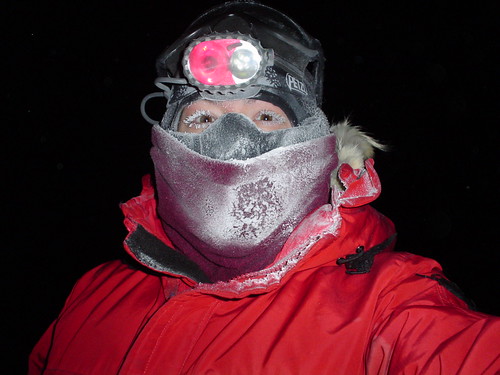another day at the office

Well, instead of sending another picture with the sky being an even darker shade, I think I'll take this little entry to tell you about what the heck I do here. Many people ask that. I ask that actually.
First, a bit of background. Not everyone here is a white-lab-coat-sporting scientist. In fact, those people, "beakers" as we call them, are actually in quite short supply. There are about 10 people here this winter who are actual beakers--employed by whatever institution or university is doing the research. The rest of us work for Raytheon, and in one way or another support this scientific research. I support it rather closely, as I am in the small department called "South Pole Science Support." There are 3 people here this winter who are in this department. The rest of the 86 people here support science in some farther-removed kind of way, such as cooking, doing construction, management, or materials handling. So that's a little background of where I fit in.
My job is to maintain, monitor, and move the coldest stuff on the planet while at the coldest place on the planet. Some people would say that they need my job for times when the South Pole just isn't cold enough. In fact, I deal with stuff that is about 350 degrees fahrenheit COLDER than the ambient temperatures here, which have been approaching -90F lately. So, yep, sometimes it's just not cold enough here. Why? Read on...
The cold stuff I deal with is liquid nitrogen and liquid helium. Liquid helium sits somewhere around -450F, and liquid nitrogen is about -300F. The beaker's telescopes have small detector arrays at the target of all the optics, which detect different kinds of radiation, like microwave, or infared. (These would be kinda like the CCD in your digital camera, only detecting different ranges of the spectrum that aren't visible light.) So they use these ultra-sensitive detectors that have to be super-cooled to make them "quiet" enough to detect the tiny radiation, and also because they have metal parts that are superconducting. So, I work with scientists to get them the cryogenic liquids that make their astronomy detectors work.
When I'm not actually schlepping the cryogenic vessels around on my snomobile sled through -80F temps freezing my fingers and such, I'm sitting in the midst of about 12,000 gallons of liquid helium inside huge vessels that I babysit. I do things like set up my computer to monitor the supply, and run plumbing to vent the gas that is constantly evaporating from the liquid, keep records, do maintenance on the plant that makes liquid nitrogen, and other lab-type things. I sometimes call myself Domino's Cryo though, because the most well-known of my job duties is delivering cryogens to the different telescopes, which are about a half mile away from station and from where my lab is. Luckily, right now, that only takes up about one morning per week of my time. This photo was taken after one of my recent cryo deliveries through -80F temps.
So that pretty much comprises the 54 hrs per week that I'm working. I'll write another one about all the amazing, adventurous, and exhilarating South Pole-type things we do in our free time here-- like knitting.
<

0 Comments:
Post a Comment
<< Home